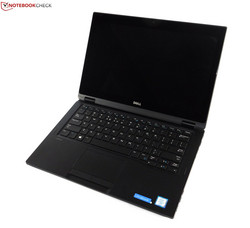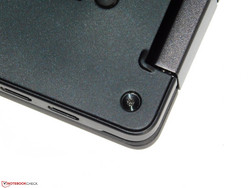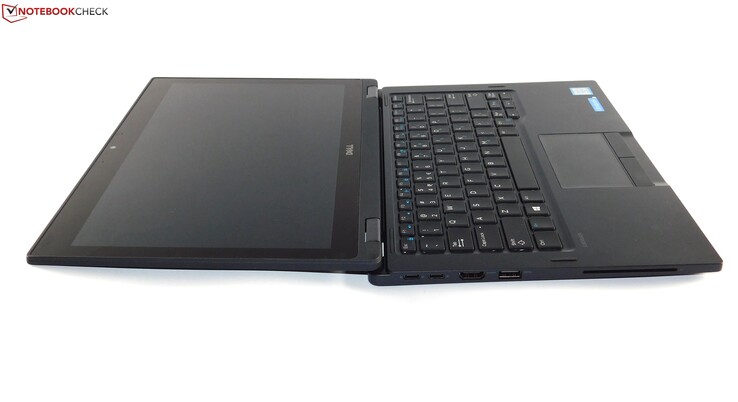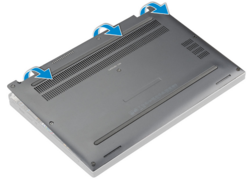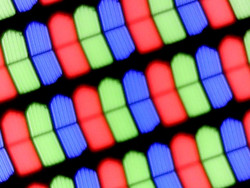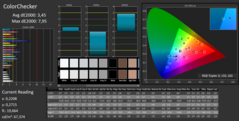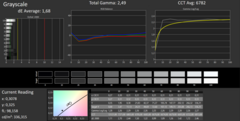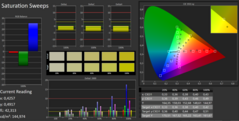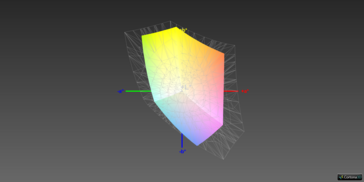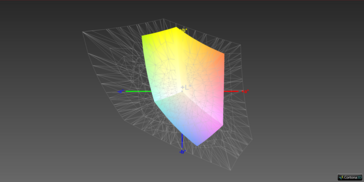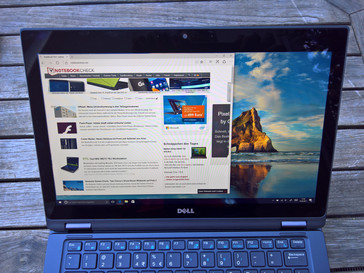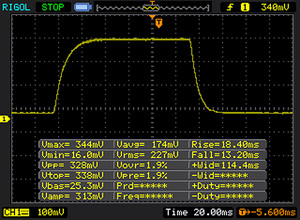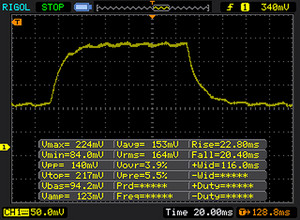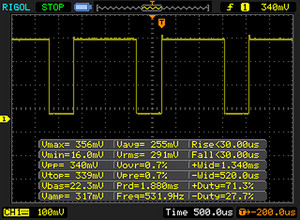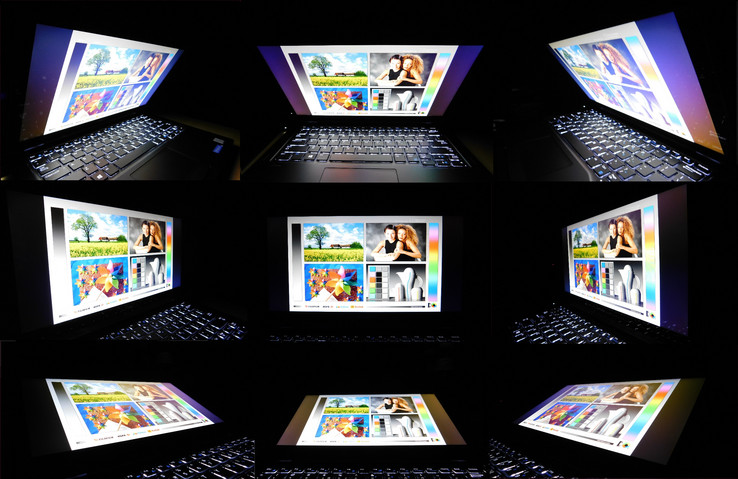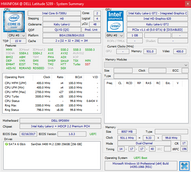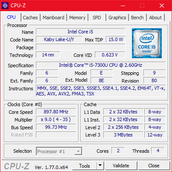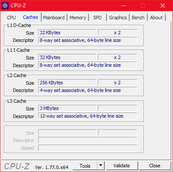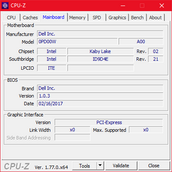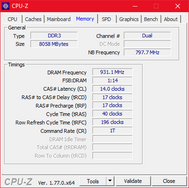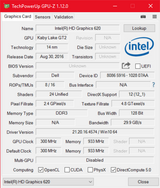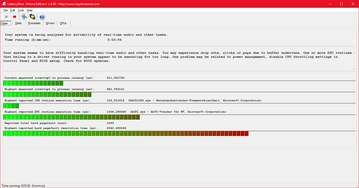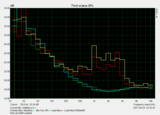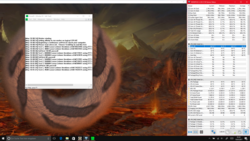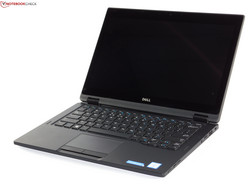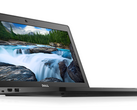Dell Latitude 5289 (i5, 256GB, 8GB) Convertible Review

For the original German review, see here.
PC convertibles have quite a long history. This sector used to be dominated by convertibles with swivel hinges, including Dell's Latitude convertibles. The last device of this series that we tested was the Latitude XT3, which was based on a 2011 Sandy Bridge processor.
A lot has changed since then, and convertibles with swivel hinges have all but disappeared from the market. Instead, convertibles with 360° hinges have established themselves, with the pioneer in the business sector being Lenovo with its ThinkPad Yoga. Dell has now caught up and can offer its own equivalent for the business sector - today's test unit, the Latitude 5289. This device is in direct competition with Lenovo's ThinkPad Yoga 370 and HP's EliteBook x360.
The entry-level US version is available for $1284 in the Dell online store. Our mid-range test unit with Core i5, 256 GB SSD and 8 GB of RAM can currently be purchased for about $1328 on the Dell online shop.
Case
One of the most important steps in developing a business notebook is creating a case that is stable, durable and practical. It seems that Dell wanted to add an additional element to the mix: inconspicuousness. This is not necessarily bad - simple design can be very beautiful. On the outside, the Latitude 5289 looks like the other models of the Latitude 5000 series. The case is angular with slightly rounded edges and the case becomes minimally slimmer towards the front. It has a deep black color, and only the shiny silver Dell logo in the middle of the display cover stands out. The exterior of the Latitude radiates professionalism - after all a desirable quality in the business sector.
Except for the Gorilla glass 4 protected display and metal hinges, the entire case has a rubber coating. This also fits well with its businesslike character; the rubber surface has more grip, so the device is less likely to slip out of your hand. It also feels pleasant to the touch and of high quality. Fingerprints and grease marks do not show up quickly, but when they do, they are not so easy to remove.
Supporting the rubber surface is magnesium, which makes the Latitude 5289 very robust and stable. Even under force, the display cover warps only minimally, the wrist rest does not give way at all. The base can be dented minimally in the middle of the keyboard, but only at unrealistically high pressure. Pressure on the display has no effect on the image. The same goes for workmanship as there are no noticeable burrs or gaps. Unfortunately, Dell did have one mishap: the device came with a stripped screw at the bottom of the case. We are assuming that this was a one-off assembly error, but it is still rather unpleasant.
Hinges play an important role in convertibles and so deserve to be examined separately. The design with two hinges is a standard for 360° convertibles; Dell has additionally designed them in a way that the display does not lie flat on the table when the device is open at 180° - unlike Lenovo and HP's competitors. Which of these two designs you prefer is a matter of taste. In any case, the hinges do a good job and hold the display securely in position without any wobbles. Unfortunately, this also means that you cannot open the display with one hand, but at least Dell added a small indentation at the front of the base. Small details like this are often not appreciated enough; the indentation makes opening the display easier.
Out test unit has a 12.5-inch display. This makes it the smallest of all the comparison devices, which all have 13.3-inch displays (except for the Yoga 910, which has a 13.9-inch display). However, it is not the smallest convertible - the XPS 13 2-in-1 is even more compact due to its thin bezels. The Latitude 5289 is the thickest device, but this also affords it more stability. Only the ThinkPad Yoga 370 is similarly thick. The XPS 13 2-in-1 is not just the smallest, but also the lightest comparison device. Our test unit is a little heavier at 1.3 kg (~2.9 pounds); the two Lenovos weigh the most at 1.4 kg (~3.3 lb).
Connectivity
Dell has given the Latitude two USB Type-C ports on its left side. However, they are both "normal" USB 3.0 ports that additionally function as DisplayPort and power supply. The Latitude 5289 does not have Thunderbolt, which puts it at a disadvantage compared to its direct competitors Lenovo and HP. Apart from that, it has a good (but not excellent) port selection for a small business notebook with two USB 3.0 Type-A ports and an HDMI port. Unfortunately, Dell has followed the trend of using MicroSD slots; the same is the case for the EliteBook x360 and ThinkPad Yoga 370.
The positions of the ports are fine, although it would have been nice to have one of the USB Type-C ports on the right, to be able to charge it from either side. But this is no real disadvantage, rather a missed chance.
Communication
The Intel Wireless 8265 is a commonly used 2x2 AC WLAN card, especially with business notebooks. This is not surprising, since it offers a stable and fast connection even at a greater distance to the router. The Latitude 5289 is no exception. In our benchmark, the Lenovo ThinkPad Yoga 370 did slightly better with the same WLAN card, but the difference is not very big.
| Networking | |
| iperf3 transmit AX12 | |
| Lenovo ThinkPad Yoga 370-20JJS00100 | |
| Dell Latitude 5289 | |
| HP EliteBook x360 1030 G2 | |
| iperf3 receive AX12 | |
| Lenovo ThinkPad Yoga 370-20JJS00100 | |
| HP EliteBook x360 1030 G2 | |
| Dell Latitude 5289 | |
Security
Unlike its direct competitors, our test unit is not equipped with a fingerprint reader, but apparently this is available optionally. It is equipped with a smart card reader, a Kensington lock slot and TPM.
Accessories
The US version of the Latitude comes with an Active Pen. For docking, you will have to resort to the USB Type-C, as more powerful Thunderbolt 3 docks cannot be used as the device has no suitable port. For this device, you would therefore need the Dell WD15 dock, which charges the notebook via USB Type-C.
Maintenance
Because of the aforementioned stripped screw, we decided not to open the test unit. In theory, the bottom cover should be easy to remove, but there are some plastic clips at the back that need to be opened. Once the bottom cover is removed, all components including the cooling fan can be accessed. The keyboard is not so easy to remove, but that has become normal for Ultrabooks.
The User's Manual, which is available on Dell's Support page, can be helpful if you want to open the device.
Warranty
A three-year warranty including on-site service is the standard warranty for the Latitude 5289. At purchase, the warranty can be extended to a maximum of five years including Next-Day service. Please see our Guarantees, Return policies and Warranties FAQ for country-specific information.
Input Devices
Keyboard
The keyboard is a little smaller than usual, which is often the case with 12.5-inch notebooks: it is about an inch less wide. Adapting to this smaller size might take some time if you are used to a full-sized keyboard. The US keyboard also has a smaller return key, but apart from that, the 6-row layout is easy to use and has standard sizes.
Dell equips all its Latitude notebooks with good keyboards - the Latitude 5289 is no exception. The matte keys have long travel for today's standards and a clear pressure point. They are slightly concave which contributes to the comfortable typing experience. The two-level backlit keyboard makes it possible to work even in darker surroundings.
Touchpad/Touchscreen
Like many other Dell Laptops, the Latitude 5289's touchpad comes from the manufacturer Alps, while most other manufacturers use Synaptics touchpads. Dell has also foregone the Microsoft Precision touchpad standard. The result: The touchpad is ordinary at best, if not below average. The touchpad reminds us of input devices of very old laptops in many ways. It is slow and inaccurate in comparison to the Precision solution. On top of the software deficiencies, the rough surface of the touchpad has a little too much grip, so using the touchpad is neither easy nor enjoyable.
Unlike Lenovo and HP, Dell has chosen to keep a touchpad with dedicated keys for their business convertible. This has the advantage that the separate keys are easier to hit and are therefore more precise. However, the disadvantage is that the touch area is rather small at 9 x 5 cm (~3.5 x 2 in), which does not improve usage. At least the keys have a comfortable feel and a good pressure point, which gives an impression of high quality.
Overall, the touchpad cannot keep up with the input devices of HP's EliteBook x360 or Lenovo's ThinkPad Yoga 370. The latter is additionally equipped with a TrackPoint, which Dell does not use either.
At least there is another, if not two alternatives: Just like all modern convertibles, Dell has used a capacitive 10-point touchscreen, which is a very precise and good alternative to the touchpad. Another possibility is using the included Active Pen, but our test unit came without one, so we could not test this feature.
Display
Dell offers only one display option for this Latitude, which saves potential buyers from having to choose one. All Latitude 5289s have a 12.5-inch IPS display with LED backlighting and a resolution of 1920x1080 pixels, which corresponds to the Full HD standard. Convertible displays tend to be glossy and both our test unit and HP and Lenovo's business competitors are no exception. There is one difference though: the screen size. Both of the other manufacturers have gone for 13.3-inch screens. The Lenovo ThinkPad Yoga 370 also has a Full HD display only, the HP EliteBook x360, however, also has a UHD option, but we tested its Full HD display.
In its specifications, Dell says the Latitude has a screen brightness of only 255 cd/m². Our test unit exceeds that value significantly. On average, it reaches 320 cd/m², which is a good value. It is a little lower than that of the Lenovo ThinkPad Yoga 370, but significantly higher than the HP EliteBook x360's screen brightness. The brightness distribution of 90% is quite good. Unfortunately, the display has both PWM and backlight bleeding, although at least the former is high enough not to be a problem for most users. The backlight bleeding, however, is quite strong and can be disturbing especially with dark contents.
| |||||||||||||||||||||||||
Brightness Distribution: 90 %
Center on Battery: 336 cd/m²
Contrast: 988:1 (Black: 0.34 cd/m²)
ΔE ColorChecker Calman: 3.45 | ∀{0.5-29.43 Ø4.78}
ΔE Greyscale Calman: 1.68 | ∀{0.09-98 Ø5}
64% sRGB (Argyll 1.6.3 3D)
41% AdobeRGB 1998 (Argyll 1.6.3 3D)
44.21% AdobeRGB 1998 (Argyll 3D)
64.3% sRGB (Argyll 3D)
42.79% Display P3 (Argyll 3D)
Gamma: 2.49
CCT: 6782 K
| Dell Latitude 5289 BOE NV12N51, , 1920x1080, 12.5" | Lenovo ThinkPad Yoga 370-20JJS00100 Sharp LQ133M1JX15, , 1920x1080, 13.3" | HP EliteBook x360 1030 G2 CMN1374, , 1920x1080, 13.3" | Dell XPS 13-9365 2-in-1 1920x1080, 13.3" | HP Spectre x360 13-w023dx Chi Mei CMN1367, , 1920x1080, 13.3" | Lenovo Yoga 910-13IKB-80VF004CGE AU Optronics AUO323D / B139HAN03.2, , 3840x2160, 13.9" | |
|---|---|---|---|---|---|---|
| Display | 56% | 46% | 11% | 48% | 43% | |
| Display P3 Coverage (%) | 42.79 | 67.9 59% | 65.5 53% | 47.32 11% | 65.4 53% | 62.2 45% |
| sRGB Coverage (%) | 64.3 | 97.3 51% | 88.8 38% | 71.1 11% | 90.4 41% | 90.1 40% |
| AdobeRGB 1998 Coverage (%) | 44.21 | 69.9 58% | 64.9 47% | 48.83 10% | 65.8 49% | 63.5 44% |
| Response Times | -3% | -10% | -10% | 16% | 7% | |
| Response Time Grey 50% / Grey 80% * (ms) | 42 ? | 42 ? -0% | 55.2 ? -31% | 48 ? -14% | 33.2 ? 21% | 46 ? -10% |
| Response Time Black / White * (ms) | 31 ? | 32.8 ? -6% | 27.2 ? 12% | 32.8 ? -6% | 28 ? 10% | 24 ? 23% |
| PWM Frequency (Hz) | 531 ? | 217.4 ? | 1042 ? | |||
| Screen | -20% | -28% | -41% | -40% | -45% | |
| Brightness middle (cd/m²) | 336 | 374 11% | 262 -22% | 322.6 -4% | 334.6 0% | 348 4% |
| Brightness (cd/m²) | 320 | 356 11% | 256 -20% | 306 -4% | 319 0% | 310 -3% |
| Brightness Distribution (%) | 90 | 87 -3% | 83 -8% | 91 1% | 90 0% | 80 -11% |
| Black Level * (cd/m²) | 0.34 | 0.33 3% | 0.25 26% | 0.19 44% | 0.336 1% | 0.25 26% |
| Contrast (:1) | 988 | 1133 15% | 1048 6% | 1698 72% | 996 1% | 1392 41% |
| Colorchecker dE 2000 * | 3.45 | 4.7 -36% | 5.13 -49% | 7.7 -123% | 6.21 -80% | 7.86 -128% |
| Colorchecker dE 2000 max. * | 7.95 | 9.5 -19% | 9.46 -19% | 11.1 -40% | 12 -51% | 13.43 -69% |
| Greyscale dE 2000 * | 1.68 | 6.5 -287% | 6.23 -271% | 7.9 -370% | 7.71 -359% | 8.25 -391% |
| Gamma | 2.49 88% | 2.19 100% | 2.45 90% | 2.88 76% | 2.36 93% | 2.05 107% |
| CCT | 6782 96% | 7086 92% | 6413 101% | 7044 92% | 6458 101% | 6834 95% |
| Color Space (Percent of AdobeRGB 1998) (%) | 41 | 63.1 54% | 57.84 41% | 44.1 8% | 58.6 43% | 58 41% |
| Color Space (Percent of sRGB) (%) | 64 | 97.2 52% | 88.57 38% | 69.9 9% | 90 41% | 90 41% |
| Total Average (Program / Settings) | 11% /
-2% | 3% /
-11% | -13% /
-26% | 8% /
-15% | 2% /
-20% |
* ... smaller is better
The contrast (988:1) and black value (0.34) are good values for an IPS display. Subjectively, black appears inky black (apart from the bothersome backlight bleeding) and the image is sharp. After calibration, the image looks even better, so we suggest using our provided ICC profile, as long as the Latitude 5289 that needs calibrating has a panel from BOE.
12.5-inch displays often have one weak point: color space coverage. The Latitude 5289 is no exception; it reaches only 64% sRGB and 41% AdobeRGB, which are bad results. The 13-inch competitors have significantly higher values. During day-to-day use, this low color space coverage should not affect the average Office user, but does show that the used IPS display is a cheap one. You can forget image processing with this screen.
Despite the shiny surface, the Latitude can be used outside, thanks to its bright screen. However, the 320 cd/m² are still not quite enough for using the device in direct sunlight, as you can see from our pictures. The image was visible, but not comfortable to read. You had better find a shady spot, as using the device in the shade is very pleasant.
Display Response Times
| ↔ Response Time Black to White | ||
|---|---|---|
| 31 ms ... rise ↗ and fall ↘ combined | ↗ 18 ms rise | |
| ↘ 13 ms fall | ||
| The screen shows slow response rates in our tests and will be unsatisfactory for gamers. In comparison, all tested devices range from 0.1 (minimum) to 240 (maximum) ms. » 83 % of all devices are better. This means that the measured response time is worse than the average of all tested devices (20.2 ms). | ||
| ↔ Response Time 50% Grey to 80% Grey | ||
| 42 ms ... rise ↗ and fall ↘ combined | ↗ 22 ms rise | |
| ↘ 20 ms fall | ||
| The screen shows slow response rates in our tests and will be unsatisfactory for gamers. In comparison, all tested devices range from 0.165 (minimum) to 636 (maximum) ms. » 66 % of all devices are better. This means that the measured response time is worse than the average of all tested devices (31.6 ms). | ||
Screen Flickering / PWM (Pulse-Width Modulation)
| Screen flickering / PWM detected | 531 Hz | ≤ 90 % brightness setting | |
The display backlight flickers at 531 Hz (worst case, e.g., utilizing PWM) Flickering detected at a brightness setting of 90 % and below. There should be no flickering or PWM above this brightness setting. The frequency of 531 Hz is quite high, so most users sensitive to PWM should not notice any flickering. In comparison: 53 % of all tested devices do not use PWM to dim the display. If PWM was detected, an average of 8111 (minimum: 5 - maximum: 343500) Hz was measured. | |||
As is usual for IPS displays, the device has good viewing-angles, although the Latitude's panel is not the best representative for IPS displays. At least there are no inverted colors (unlike with TN panels), but you do lose some brightness and experience a change in color temperature from wider angels. But this does not really affect day-to-day work negatively.
Neither the two USB Type-C ports with DisplayPort, nor the HDMI port showed any problems with image output, so connecting the device to projectors or external monitors should work well.
Performance
Dell's Latitude 5289 covers a price range of $1284 to $2,670 with four different processor configurations. At entry level you will, however, only get an i3 processor (Core i3-7100U), a 128 GB SSD and 4 GB of RAM (LPDDR3-1866). The latter has the most severe implications as the RAM is firmly soldered on. We recommend thinking properly about which RAM configuration you need before purchase - 4 GB is quite tight in 2017. The maximum RAM available is 16 GB, but only the most expensive version ($2130) is equipped with that configuration, as well as the i7-7600U. The two lower-priced US versions can be equipped with SSDs of up to 512 GB, while the two more expensive models can be configured with up to 1 TB PCIe SSDs. Our test unit is equipped with a 256 GB SATA III SSD. The SSDs should be easily exchangeable later on.
The users have no options concerning graphics - the device comes with the normal iGPU only. But that is not surprising for a small convertible. On top of RAM, CPU and SSD, users should also take a look at the battery. Some models only have a 45 Wh battery, while our test unit has a larger 60 Wh battery.
Processor
The Core i5-7300U is the faster of the two Intel Core i5 CPUs of the U series (with a TDP of 15 Wh). It is used a lot less than its slower sister version, the i5-7200U, which is probably because the speed advantage is not that big and that the more expensive i5-7300U has vPro - a function that private users are not likely to need. The two cores of the i5-7300U clock at a maximum of 3.5 GHz with an average clock rate of 2.6 GHz. Please check our CPU database for more information.
In order to test a notebook's performance in day-to-day use, we make all laptops do a short endurance test: the Cinebench Multicore benchmark runs in a loop for 30 minutes. If the performance drops, we know that the full CPU performance will not be available for long during day-to-day use. We noticed this on the Latitude 5289 as well. The power dropped to about 325 points after the first round, which is just below the Core i7-7200U performance. After that, the CPU stays at that level. The reason behind this drop is the TDP (Thermal Design Power) of 15 Wh. During the first round, the CPU is allowed to consume 21 Wh for about 30 seconds, during which it can use the maximum clock rate of 3.5 GHz. After that, the TDP limit of 15 Wh sets in and the clock rate drops to 3 GHz. There is no throttling, but maximum performance is not reached either.
The Latitude 5289 with the i5-7300U delivers quite good results in the individual tests - above the usual results for the i5-7200U, which typically reaches 330 points. Our test unit cannot make the most of its processor, which you can see from looking at the slightly better results of the EliteBook x360 with the same CPU. But it still beats the Lenovo ThinkPad Yoga 370 with the i5-7200U processor. (That device is even farther away from reaching its full potential.) You can compare more CPUs with our CPU benchmark tool.
Our test unit CPU performs just as well on battery power as when connected to a power supply.
System Performance
Nothing bad can be said regarding system performance. Both during normal use and during the tests our test unit performed relatively well and ranks average in the benchmarks. Subjectively, everything runs smoothly.
| PCMark 8 Home Score Accelerated v2 | 3554 points | |
| PCMark 8 Work Score Accelerated v2 | 4681 points | |
Help | ||
Storage Devices
As mentioned above, our test unit contains an SSD with a capacity of 256 GB. It was produced by SanDisk and the model is X400. It is a normal SATA III SSD, but Dell's Latitude 5289 is also available with the more expensive PCIe SSDs in the US. This means the Latitude is at a disadvantage in the benchmark comparison. The EliteBook x360 is the only other device with the cheaper SATA III configuration. The test unit would probably have done better in the PCMark-Test if it had a PCIe SSD. It would be possible to mount a PCIe SSD later on, if needed.
You can compare the SanDisk X400 with other SSDs in our HDD/SSD Benchmark table.
| Dell Latitude 5289 SanDisk X400 256GB, SATA (SD8SB8U-256G) | Lenovo ThinkPad Yoga 370-20JJS00100 Toshiba NVMe THNSF5512GPUK | HP EliteBook x360 1030 G2 Sandisk SD8TN8U-256G-1006 | Dell XPS 13-9365 2-in-1 Toshiba NVMe THNSN5256GPUK | HP Spectre x360 13-w023dx Samsung PM951 NVMe MZVLV512 | Lenovo Yoga 910-13IKB-80VF004CGE Samsung PM951 NVMe MZVLV512 | |
|---|---|---|---|---|---|---|
| CrystalDiskMark 3.0 | 128% | 33% | 130% | 154% | 179% | |
| Read Seq (MB/s) | 423.7 | 1070 153% | 467.1 10% | 1206 185% | 1376 225% | 1412 233% |
| Write Seq (MB/s) | 406.4 | 484.5 19% | 443.6 9% | 629 55% | 571 41% | 578 42% |
| Read 512 (MB/s) | 260.8 | 680 161% | 312.3 20% | 966 270% | 679 160% | 701 169% |
| Write 512 (MB/s) | 255.6 | 483.1 89% | 372.5 46% | 410.7 61% | 571 123% | 580 127% |
| Read 4k (MB/s) | 22.73 | 30.55 34% | 29.43 29% | 32.93 45% | 42.66 88% | 43.5 91% |
| Write 4k (MB/s) | 27.92 | 127.3 356% | 56.5 102% | 121.2 334% | 137.9 394% | 159.7 472% |
| Read 4k QD32 (MB/s) | 306.2 | 460.8 50% | 311.3 2% | 411 34% | 535 75% | 570 86% |
| Write 4k QD32 (MB/s) | 158.8 | 414.5 161% | 225.2 42% | 250.2 58% | 361.2 127% | 488.7 208% |
Graphics
The Intel HD Graphics 620 is one of the most tested graphics unit of the current notebook generation. After all, the GT2 based (24 Execution Units) iGPU is featured in every device with a U series processor - which is basically the standard for notebooks nowadays.
The device's storage solution is crucial to the performance of the HD 620, as it has no memory of its own. If only one memory module is available, as is the case in the ThinkPad Yoga 370, the maximum performance is limited. This is called single channel mode. If there is a second memory module available, the GPU can perform better thanks to dual-channel mode. In the case of the Latitude 5289, the memory is soldered on and runs in dual-channel mode. That should be the main reason why the test unit does quite a good job in the benchmarks. It is 18 to 22 percent faster than the ThinkPad Yoga 370's single channel mode. As always, you can also compare GPUs in our GPU Benchmark Tool.
The GPU performs just as well in battery mode and on power supply.
| 3DMark 11 - 1280x720 Performance GPU | |
| Dell Latitude 5289 | |
| Lenovo Yoga 910-13IKB-80VF004CGE | |
| HP Spectre x360 13-w023dx | |
| HP EliteBook x360 1030 G2 | |
| Dell XPS 13-9365 2-in-1 | |
| Lenovo ThinkPad Yoga 370-20JJS00100 | |
| 3DMark 11 Performance | 1787 points | |
| 3DMark Cloud Gate Standard Score | 6359 points | |
| 3DMark Fire Strike Score | 931 points | |
Help | ||
Gaming Performance
When you hear the name "Latitude", gaming is probably the last thing you will think of. Still, gaming probably plays a role for some people, as diligent keyboard-warriors might like to treat themselves to a quick game after work.
But of course the Latitude 5289 is not made for that - which becomes clear in the game benchmarks. Current games are a complete no-go and even older games are not playable with high details and 1080p.
If you want to play games in good quality, you had better look for a multimedia or gaming laptop.
| low | med. | high | ultra | |
|---|---|---|---|---|
| BioShock Infinite (2013) | 53.6 | 32.6 | 27.7 | 8.6 |
| Company of Heroes 2 (2013) | 22.6 | |||
| Rise of the Tomb Raider (2016) | 20.8 |
Emissions
System Noise
The test unit's fan is nice and quiet. While idling, the cooling fan is turned off, and even under load, it does not run too high. It is clearly audible, but not disturbing.
What is more disturbing is the penetrating coil whine that is regularly audible during use. This is a clear minus point for sensitive users and will negatively impact our total rating.
Noise level
| Idle |
| 30.5 / 30.5 / 30.5 dB(A) |
| Load |
| 36 / 34.6 dB(A) |
 | ||
30 dB silent 40 dB(A) audible 50 dB(A) loud |
||
min: | ||
Temperature
As is typical for an Ultrabook, the Latitude 5289 remains completely cool while idling. It does heat up noticeably under load in some areas, although a temperature of 49 °C (~120 °F) is still acceptable. Luckily, the wrist rest remains cool. The bottom of the base heats up in some areas, not enough to have to worry about burning yourself.
Taking a look at the internal temperature values during the stress test, you can see that the stress test reflects the results of the Cinebench loop test quite well. The system can go over the TDP limit for about 30 seconds - although in this case the CPU clocks at only 3 GHz as the iGPU is running at full capacity as well. After that, the CPU clock rate sinks to 1.8 GHz at which it stays for the remainder of the test. These results show that the TPD does cause throttling, which is typical for Ultrabook processors. The manufacturer could probably avoid this by increasing the TDP to 25 Wh, but then the temperatures would probably increase a lot, as these are held in check by the throttling.
The 3DMark11 test that we did after the stress test brought average results.
(-) The maximum temperature on the upper side is 49 °C / 120 F, compared to the average of 35.4 °C / 96 F, ranging from 19.6 to 60 °C for the class Convertible.
(±) The bottom heats up to a maximum of 44.4 °C / 112 F, compared to the average of 36.8 °C / 98 F
(+) In idle usage, the average temperature for the upper side is 26.4 °C / 80 F, compared to the device average of 30.3 °C / 87 F.
(+) The palmrests and touchpad are cooler than skin temperature with a maximum of 30.2 °C / 86.4 F and are therefore cool to the touch.
(-) The average temperature of the palmrest area of similar devices was 27.9 °C / 82.2 F (-2.3 °C / -4.2 F).
Speakers
The stereo speakers are placed at the bottom, near the front of the base unit. The sound is directed out of the case via the bottom of the base. Therefore, the quality of the sound depends on what the device is standing on; if it is standing on something soft, the sound will be muted. The Latitude's sound itself is nothing special and rather typical for notebook speakers: low frequencies are hardly audible and the sound is not particularly loud.
The sound quality improves significantly when you connect external speakers or headphones via the flawless 3.5mm combined audio jack.
Dell Latitude 5289 audio analysis
(-) | not very loud speakers (69 dB)
Bass 100 - 315 Hz
(-) | nearly no bass - on average 19.6% lower than median
(±) | linearity of bass is average (11.1% delta to prev. frequency)
Mids 400 - 2000 Hz
(+) | balanced mids - only 3.2% away from median
(±) | linearity of mids is average (7.7% delta to prev. frequency)
Highs 2 - 16 kHz
(±) | higher highs - on average 5.2% higher than median
(±) | linearity of highs is average (9.5% delta to prev. frequency)
Overall 100 - 16.000 Hz
(±) | linearity of overall sound is average (23.2% difference to median)
Compared to same class
» 70% of all tested devices in this class were better, 5% similar, 26% worse
» The best had a delta of 6%, average was 20%, worst was 57%
Compared to all devices tested
» 69% of all tested devices were better, 5% similar, 26% worse
» The best had a delta of 4%, average was 24%, worst was 134%
Apple MacBook 12 (Early 2016) 1.1 GHz audio analysis
(+) | speakers can play relatively loud (83.6 dB)
Bass 100 - 315 Hz
(±) | reduced bass - on average 11.3% lower than median
(±) | linearity of bass is average (14.2% delta to prev. frequency)
Mids 400 - 2000 Hz
(+) | balanced mids - only 2.4% away from median
(+) | mids are linear (5.5% delta to prev. frequency)
Highs 2 - 16 kHz
(+) | balanced highs - only 2% away from median
(+) | highs are linear (4.5% delta to prev. frequency)
Overall 100 - 16.000 Hz
(+) | overall sound is linear (10.2% difference to median)
Compared to same class
» 7% of all tested devices in this class were better, 2% similar, 91% worse
» The best had a delta of 5%, average was 18%, worst was 53%
Compared to all devices tested
» 4% of all tested devices were better, 1% similar, 94% worse
» The best had a delta of 4%, average was 24%, worst was 134%
Frequency diagram in comparison (checkboxes above can be turned on/off)
Energy Management
Power Consumption
The Latitude 5289 has great values, especially while idling. Out of all comparison devices with 15 W U processors, it is clearly the most energy-efficient device. Only the Dell XPS 13 2-in-1 is better - but that is equipped with a considerably more energy-efficient Y processor. At least the minimal idle value is lower in the Latitude 5289 despite the stronger CPU. Dell did a good job here.
The test unit comes with a 65 Wh power supply with a USB-C connector. The 65 Wh are more than enough, theoretically Dell could have also used a 45 Wh power supply.
| Off / Standby | |
| Idle | |
| Load |
|
Key:
min: | |
| Dell Latitude 5289 i5-7300U, HD Graphics 620, SanDisk X400 256GB, SATA (SD8SB8U-256G), IPS LED, 1920x1080, 12.5" | Lenovo ThinkPad Yoga 370-20JJS00100 i5-7200U, HD Graphics 620, Toshiba NVMe THNSF5512GPUK, IPS LED, 1920x1080, 13.3" | HP EliteBook x360 1030 G2 i5-7300U, HD Graphics 620, Sandisk SD8TN8U-256G-1006, IPS, 1920x1080, 13.3" | Dell XPS 13-9365 2-in-1 i7-7Y75, HD Graphics 615, Toshiba NVMe THNSN5256GPUK, IPS, 1920x1080, 13.3" | HP Spectre x360 13-w023dx i7-7500U, HD Graphics 620, Samsung PM951 NVMe MZVLV512, IPS, 1920x1080, 13.3" | Lenovo Yoga 910-13IKB-80VF004CGE i7-7500U, HD Graphics 620, Samsung PM951 NVMe MZVLV512, IPS, 3840x2160, 13.9" | |
|---|---|---|---|---|---|---|
| Power Consumption | -17% | -9% | 17% | -30% | -20% | |
| Idle Minimum * (Watt) | 2.7 | 3.6 -33% | 3.2 -19% | 3.1 -15% | 5.5 -104% | 4.3 -59% |
| Idle Average * (Watt) | 5.1 | 7.2 -41% | 5.5 -8% | 4.3 16% | 6.7 -31% | 6.3 -24% |
| Idle Maximum * (Watt) | 7.6 | 8.4 -11% | 6.5 14% | 4.9 36% | 7.1 7% | 9 -18% |
| Load Average * (Watt) | 33 | 29.9 9% | 29.7 10% | 24.3 26% | 33.1 -0% | 32.7 1% |
| Load Maximum * (Watt) | 29 | 32.2 -11% | 41.3 -42% | 22.8 21% | 35.2 -21% | 28.8 1% |
* ... smaller is better
Battery Runtime
The low consumption rates and comparatively enormous 60 Wh battery that our test unit is equipped with ensure excellent battery runtimes. During our practically oriented Wi-Fi test, the Latitude even beats the EliteBook x360 , which already has very good runtimes. Our test unit was on for 28 hours during our idle test - the longest time by far. It only lagged behind a little while testing its battery runtime under load.
It takes about 1.5 hours for the battery to recharge fully, which is quite fast for a 60 Wh battery.
| Dell Latitude 5289 i5-7300U, HD Graphics 620, 60 Wh | Lenovo ThinkPad Yoga 370-20JJS00100 i5-7200U, HD Graphics 620, 51 Wh | HP EliteBook x360 1030 G2 i5-7300U, HD Graphics 620, 57 Wh | Dell XPS 13-9365 2-in-1 i7-7Y75, HD Graphics 615, 46 Wh | HP Spectre x360 13-w023dx i7-7500U, HD Graphics 620, 57.8 Wh | Lenovo Yoga 910-13IKB-80VF004CGE i7-7500U, HD Graphics 620, 78 Wh | |
|---|---|---|---|---|---|---|
| Battery runtime | -24% | 16% | -7% | -21% | -7% | |
| Reader / Idle (h) | 28.8 | 19.4 -33% | 23.1 -20% | 16.2 -44% | 20.6 -28% | 17.8 -38% |
| WiFi v1.3 (h) | 11.8 | 8.1 -31% | 10.5 -11% | 11.4 -3% | 9.3 -21% | 10.7 -9% |
| Load (h) | 2.3 | 2.1 -9% | 4.1 78% | 2.9 26% | 2 -13% | 2.9 26% |
| H.264 (h) | 9.6 | 11 |
Verdict
Pros
Cons
Choosing a business convertible is not easy. After all the ThinkPad Yoga 370 and the EliteBook x360 alone are two good alternatives. With the Latitude 5289, Dell has contributed an interesting competitor. The biggest advantage of today's test unit: its battery runtime. Thanks to low energy consumption and a very large battery, the Latitude is the best device in this area. The robust case and comfortable keyboard are also worth considering. The Latitude 5289's cooling fan remains quiet thanks to its ULV CPU. The selection of ports is suitable for a business device, which brings us to the negative aspects.
A device that is clearly above the $1,000 mark should be equipped with Thunderbolt 3 and its competitors all feature the port. The cooling fan does not run very often, but Dell has not managed to get rid of the bothersome coil whine. The keyboard is good; the touchpad, however, is not impressive; especially in comparison to the competitors from HP and Lenovo, the touchpad Dell chose is not great. Unlike Lenovo and HP, Dell has chosen to keep the 12.5-inch display. This can be an advantage or a disadvantage: you have less work surface, but also less weight. A typical disadvantage of 12.5-inch displays is the lacking color space coverage. On top of that, the display has high backlight bleeding. At least it is bright enough to use outdoors.
Dell has created a good convertible: its long battery runtime is particularly captivating. But it is not easy to keep up in this highly competitive market, and Dell did make some mistakes.
The Latitude 5289 is definitely not a bad convertible. If you are looking for a convertible notebook with the longest possible battery runtime, then this could even be a recommendable choice. However, the alternatives - ThinkPad Yoga 370 and EliteBook x360 - equally have their strong points. The entry-level model of the Latitude costs less, but you also get a worse configuration with only 4 GB of soldered-on working memory. Overall, the Latitude has a hard time asserting itself against its competitors. It could beat them with a better 13.3-inch display and an improved touchpad. Instead, it remains in third place despite its great battery runtime, particularly because both Lenovo's and HP's models offer good battery runtimes as well.
Dell Latitude 5289
- 05/16/2017 v6 (old)
Benjamin Herzig




